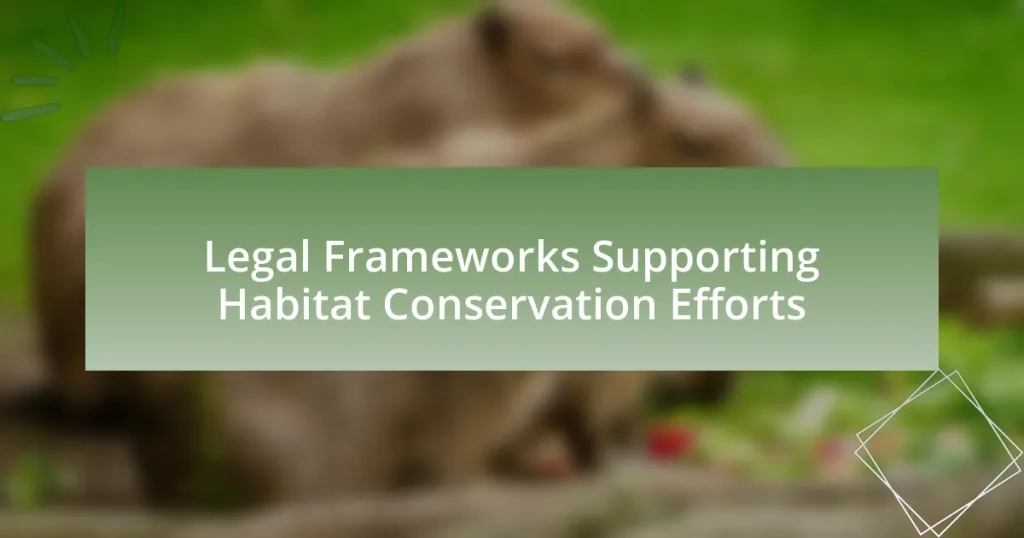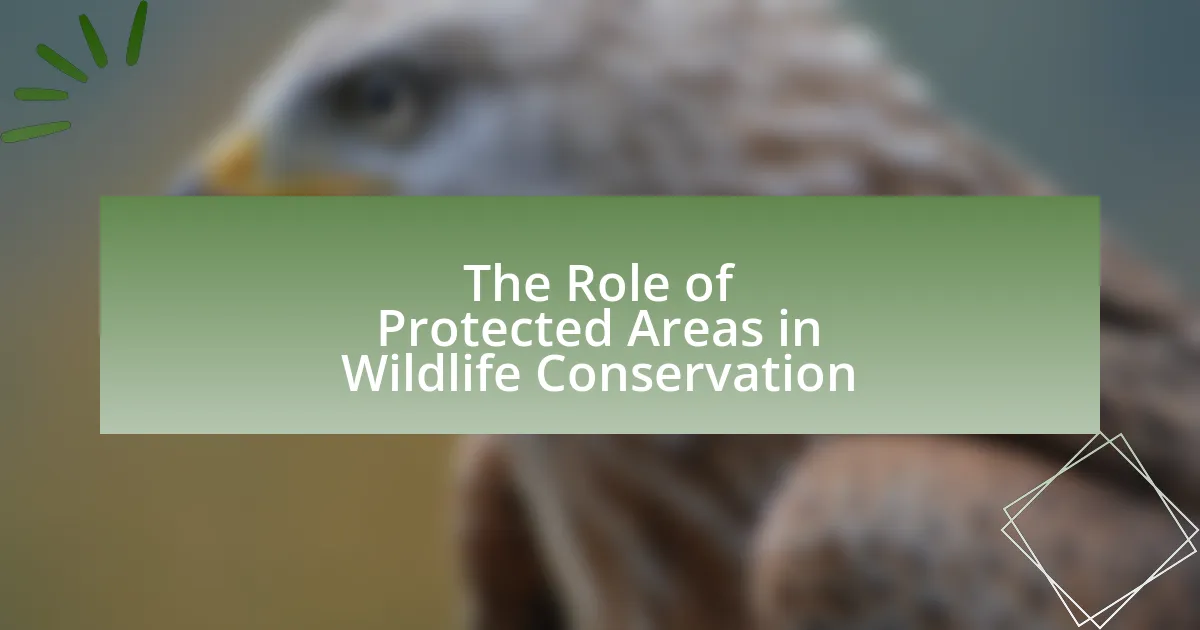Legal frameworks supporting habitat conservation efforts encompass international treaties, national laws, and local regulations designed to protect ecosystems and biodiversity. Key examples include the Convention on Biological Diversity and the Endangered Species Act, which establish legal obligations for habitat preservation and species protection. These frameworks function by providing regulations, enforcement mechanisms, and stakeholder engagement strategies that promote sustainable land use and conservation practices. The article explores the components of these legal frameworks, their effectiveness in protecting endangered species, the challenges they face, and the role of public awareness in enhancing compliance and support for conservation laws.
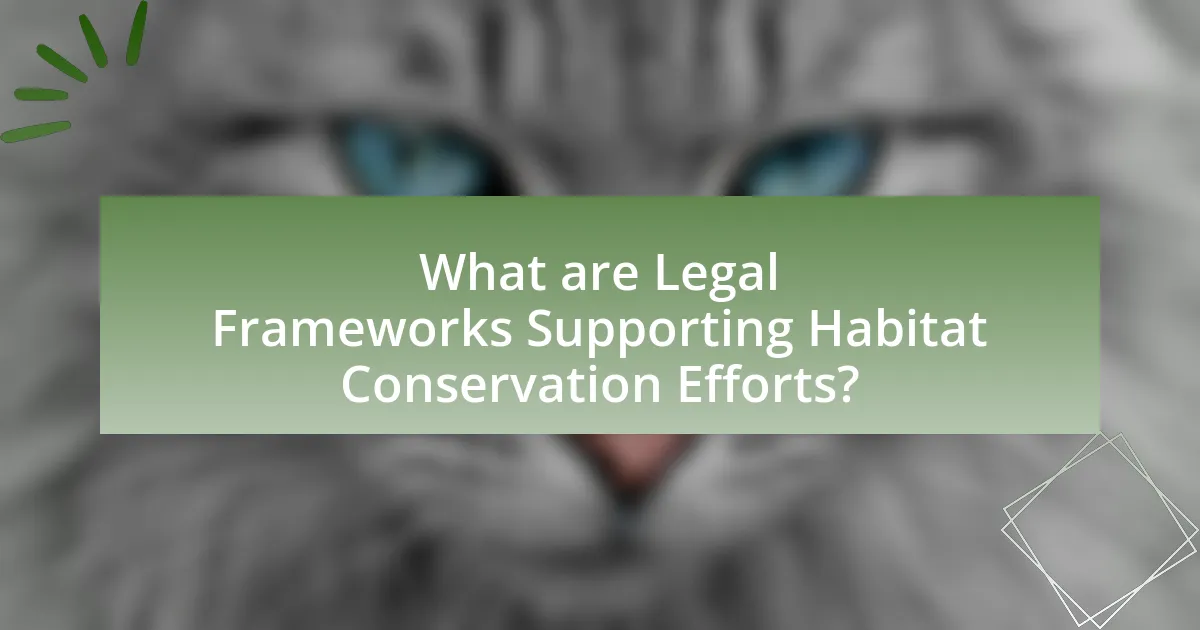
What are Legal Frameworks Supporting Habitat Conservation Efforts?
Legal frameworks supporting habitat conservation efforts include international treaties, national laws, and local regulations aimed at protecting ecosystems and biodiversity. Key examples are the Convention on Biological Diversity, which obligates signatory countries to develop national strategies for biodiversity conservation, and the Endangered Species Act in the United States, which provides for the protection of threatened and endangered species and their habitats. These frameworks are essential for establishing legal obligations and guidelines that promote habitat preservation, restoration, and sustainable management, thereby ensuring the long-term viability of various species and ecosystems.
How do these legal frameworks function in habitat conservation?
Legal frameworks function in habitat conservation by establishing regulations and guidelines that protect ecosystems and biodiversity. These frameworks, such as the Endangered Species Act in the United States, provide legal mechanisms for the designation of protected areas, the regulation of land use, and the enforcement of conservation measures. For instance, the Endangered Species Act mandates federal agencies to ensure that actions they authorize do not jeopardize the existence of listed species or destroy their critical habitats, thereby directly influencing habitat conservation efforts. Additionally, international agreements like the Convention on Biological Diversity promote collaborative conservation strategies among nations, reinforcing the importance of legal structures in safeguarding habitats globally.
What are the key components of these legal frameworks?
The key components of legal frameworks supporting habitat conservation efforts include legislation, regulatory mechanisms, enforcement provisions, and stakeholder engagement. Legislation establishes the legal basis for habitat protection, such as the Endangered Species Act in the United States, which provides specific protections for threatened and endangered species and their habitats. Regulatory mechanisms outline the procedures and standards for habitat management, including land-use planning and environmental assessments. Enforcement provisions ensure compliance with the laws and regulations, often involving penalties for violations. Lastly, stakeholder engagement involves collaboration with local communities, governments, and organizations to promote conservation goals, exemplified by initiatives like the Convention on Biological Diversity, which encourages participation from various sectors in habitat conservation efforts.
How do these components interact to promote habitat conservation?
Legal frameworks, such as environmental laws, regulations, and policies, interact with stakeholders, including governments, NGOs, and local communities, to promote habitat conservation. These components work together by establishing legal protections for habitats, facilitating funding for conservation projects, and ensuring compliance through enforcement mechanisms. For instance, the Endangered Species Act in the United States provides a legal basis for protecting critical habitats, which directly supports biodiversity conservation efforts. Additionally, collaborative initiatives, such as conservation easements, involve landowners and conservation organizations in legally binding agreements that protect habitats while allowing for sustainable land use. This synergy between legal frameworks and stakeholder engagement enhances the effectiveness of habitat conservation strategies.
Why are legal frameworks essential for habitat conservation?
Legal frameworks are essential for habitat conservation because they establish the legal basis for protecting ecosystems and biodiversity. These frameworks create enforceable regulations that govern land use, resource extraction, and pollution, thereby preventing habitat degradation. For instance, the Endangered Species Act in the United States provides legal protections for threatened and endangered species and their habitats, demonstrating how specific laws can directly contribute to conservation efforts. Additionally, legal frameworks facilitate international cooperation, as seen in agreements like the Convention on Biological Diversity, which aims to conserve biological diversity globally. Such laws not only promote sustainable practices but also hold individuals and organizations accountable, ensuring that habitat conservation is prioritized and effectively implemented.
What role do they play in protecting endangered species?
Legal frameworks play a crucial role in protecting endangered species by establishing regulations and guidelines that govern habitat conservation and species management. These laws, such as the Endangered Species Act in the United States, provide mechanisms for the identification of endangered species, the designation of critical habitats, and the implementation of recovery plans. For instance, the Endangered Species Act has successfully led to the recovery of species like the American bald eagle, which was removed from the endangered species list in 2007 due to effective legal protections and habitat restoration efforts.
How do they influence land use and development policies?
Legal frameworks influence land use and development policies by establishing regulations and guidelines that govern how land can be utilized and developed. These frameworks, such as zoning laws, environmental protection statutes, and land-use planning regulations, dictate permissible activities on land, thereby shaping development patterns. For instance, the National Environmental Policy Act (NEPA) requires federal agencies to assess environmental impacts before undertaking projects, which can limit development in sensitive areas. Additionally, local zoning ordinances can restrict land use to preserve habitats, ensuring that development aligns with conservation goals. This regulatory environment directly impacts decisions made by developers, landowners, and policymakers, ultimately guiding sustainable land use practices.
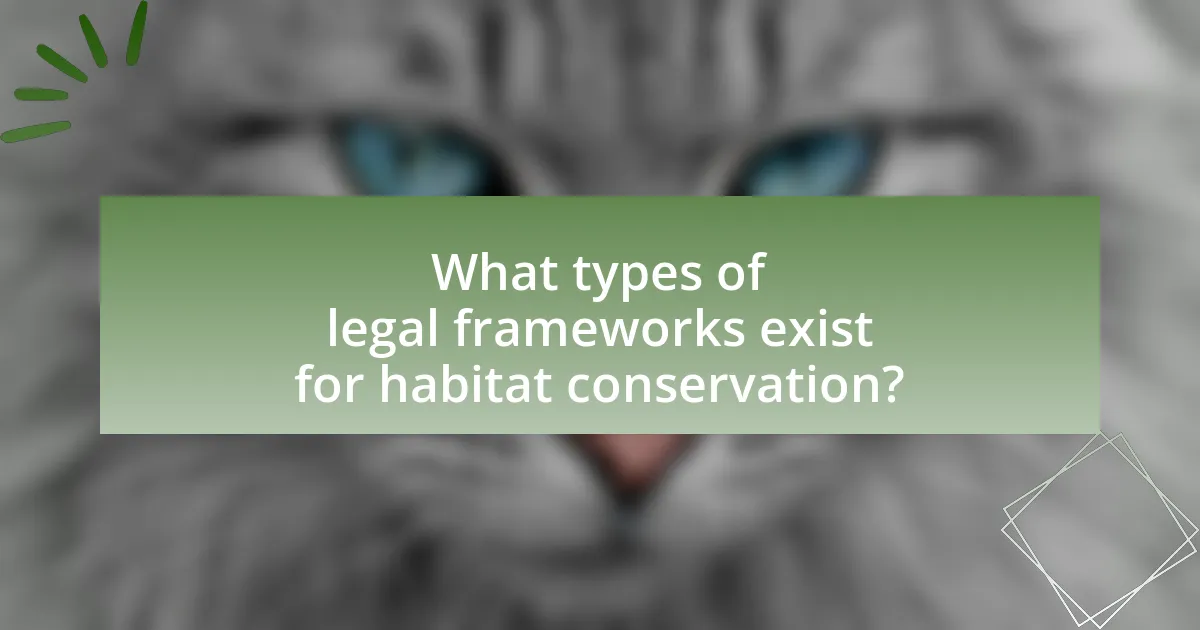
What types of legal frameworks exist for habitat conservation?
Various legal frameworks exist for habitat conservation, including international treaties, national laws, and local regulations. International treaties such as the Convention on Biological Diversity and the Ramsar Convention on Wetlands provide guidelines for member countries to protect habitats. National laws, like the Endangered Species Act in the United States, establish protections for specific species and their habitats. Additionally, local regulations often include zoning laws and land-use planning that aim to conserve natural areas. These frameworks collectively contribute to habitat conservation by setting legal standards and obligations for protection and sustainable management.
How do international treaties contribute to habitat conservation?
International treaties contribute to habitat conservation by establishing binding commitments among nations to protect and manage natural resources and ecosystems. These treaties, such as the Convention on Biological Diversity and the Ramsar Convention on Wetlands, create frameworks for cooperation, setting standards for conservation practices and promoting sustainable use of habitats. For instance, the Convention on Biological Diversity, adopted in 1992, aims to conserve biological diversity, ensure sustainable use of its components, and promote fair sharing of benefits arising from genetic resources, thereby directly influencing habitat conservation efforts globally.
What are some examples of significant international treaties?
Significant international treaties include the Convention on Biological Diversity (CBD), the Ramsar Convention on Wetlands, and the Paris Agreement on climate change. The CBD, established in 1992, aims to conserve biological diversity, promote sustainable use of its components, and ensure fair sharing of benefits arising from genetic resources. The Ramsar Convention, adopted in 1971, focuses on the conservation and sustainable use of wetlands, recognizing their ecological importance. The Paris Agreement, adopted in 2015, seeks to limit global warming and its impacts, emphasizing the need for international cooperation in addressing climate change, which directly affects habitats worldwide.
How do these treaties enforce compliance among nations?
Treaties enforce compliance among nations through mechanisms such as binding legal obligations, monitoring systems, and sanctions for non-compliance. These legal frameworks create specific commitments that countries must adhere to, often backed by international law, which holds nations accountable. For instance, the Convention on Biological Diversity requires signatory countries to develop national strategies for biodiversity conservation, and failure to comply can lead to diplomatic pressure or loss of international funding. Additionally, treaties often include reporting requirements and independent assessments to ensure transparency and accountability, further reinforcing compliance among nations.
What national laws are pivotal for habitat conservation?
The Endangered Species Act (ESA) is a pivotal national law for habitat conservation in the United States. Enacted in 1973, the ESA aims to protect and recover imperiled species and their ecosystems by prohibiting the destruction of critical habitats. The law has led to the designation of over 1,800 species as endangered or threatened, which in turn has resulted in the protection of millions of acres of habitat across the country. Additionally, the National Environmental Policy Act (NEPA) requires federal agencies to assess the environmental impacts of their proposed actions, ensuring that habitat conservation is considered in decision-making processes. These laws collectively play a crucial role in safeguarding biodiversity and promoting habitat conservation efforts.
Which countries have the most effective habitat conservation laws?
Countries with the most effective habitat conservation laws include Costa Rica, Germany, and Australia. Costa Rica is renowned for its comprehensive environmental legislation, which includes the Payment for Ecosystem Services program that incentivizes landowners to conserve forests. Germany has robust laws that integrate biodiversity protection into land-use planning, supported by the Federal Nature Conservation Act. Australia’s Environment Protection and Biodiversity Conservation Act provides a strong framework for protecting habitats and species, with strict regulations on land clearing and development. These countries demonstrate effective legal frameworks that prioritize habitat conservation through specific, enforceable laws and programs.
How do these laws vary across different regions?
Laws supporting habitat conservation efforts vary significantly across different regions due to local environmental priorities, cultural values, and governance structures. For instance, in North America, the Endangered Species Act provides a robust framework for protecting threatened species and their habitats, while in Europe, the Habitats Directive emphasizes the conservation of natural habitats and wild fauna and flora. In contrast, regions in Africa may rely on community-based conservation laws that integrate local knowledge and practices, reflecting a different approach to habitat protection. These variations are influenced by factors such as biodiversity levels, economic development, and historical land use practices, demonstrating that legal frameworks are tailored to meet the specific ecological and social contexts of each region.
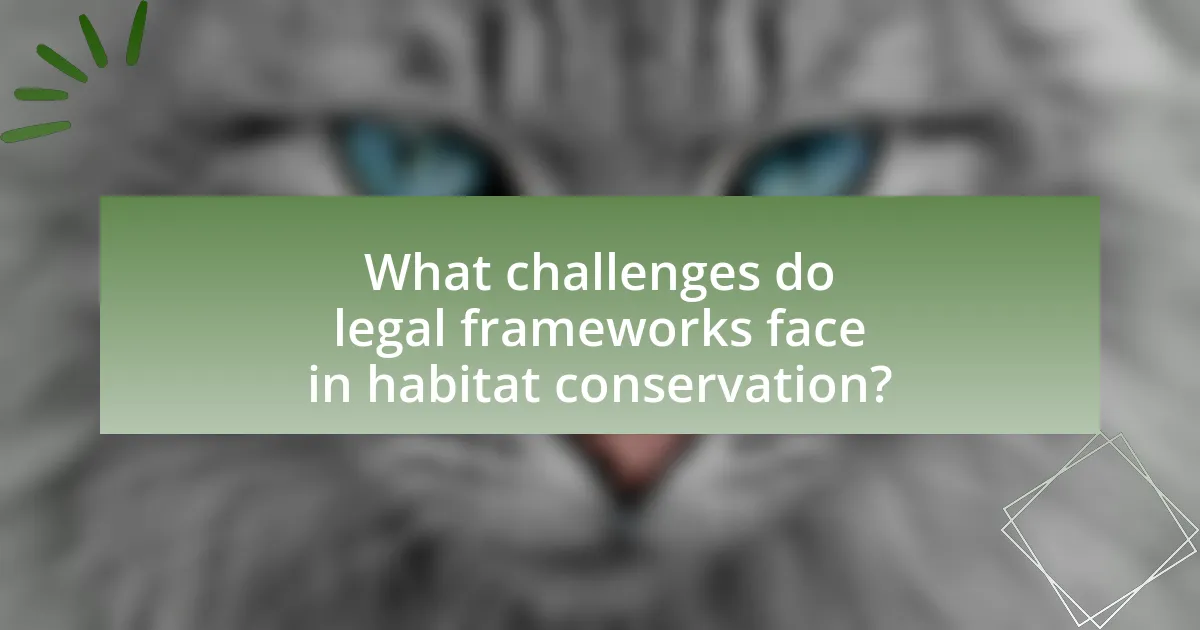
What challenges do legal frameworks face in habitat conservation?
Legal frameworks face significant challenges in habitat conservation, primarily due to inadequate enforcement mechanisms and conflicting land-use policies. These frameworks often lack the necessary resources and political will to implement and enforce conservation laws effectively, leading to insufficient protection for critical habitats. For instance, a study by the World Wildlife Fund highlights that many countries have laws in place, but only a fraction of protected areas are effectively managed, resulting in habitat degradation. Additionally, competing interests from agriculture, urban development, and resource extraction frequently undermine conservation efforts, as seen in regions where economic incentives outweigh environmental considerations.
How do enforcement issues impact habitat conservation efforts?
Enforcement issues significantly hinder habitat conservation efforts by allowing illegal activities such as poaching, deforestation, and pollution to persist unchecked. For instance, inadequate monitoring and lack of resources for enforcement agencies lead to a failure in protecting designated conservation areas, resulting in habitat degradation. According to a study published in the journal “Conservation Biology,” regions with weak enforcement mechanisms experience a 50% higher rate of biodiversity loss compared to areas with robust legal frameworks and enforcement practices. This evidence underscores the critical role that effective enforcement plays in ensuring the success of habitat conservation initiatives.
What are common barriers to effective enforcement?
Common barriers to effective enforcement include insufficient resources, lack of training, and inadequate legal frameworks. Insufficient resources hinder the ability of enforcement agencies to monitor and respond to violations effectively, as seen in many regions where funding cuts limit patrols and investigations. Lack of training results in enforcement personnel being ill-equipped to handle complex legal and ecological issues, which can lead to inconsistent application of laws. Inadequate legal frameworks may create loopholes or ambiguities that complicate enforcement actions, making it difficult to prosecute offenders or protect habitats effectively. These barriers collectively undermine the enforcement of habitat conservation laws and regulations.
How can these barriers be overcome?
Barriers to habitat conservation can be overcome through the implementation of comprehensive legal frameworks that promote collaboration among stakeholders. Effective legislation, such as the Endangered Species Act in the United States, provides mechanisms for protecting critical habitats and enforcing conservation measures. Additionally, integrating local communities in decision-making processes fosters support and compliance, as evidenced by successful initiatives in Costa Rica where community-based conservation has led to increased biodiversity and habitat protection. Furthermore, securing funding for conservation projects through public-private partnerships enhances resource availability, enabling the execution of conservation strategies.
What role does public awareness play in supporting legal frameworks?
Public awareness plays a crucial role in supporting legal frameworks by fostering community engagement and promoting compliance with environmental laws. When the public is informed about habitat conservation issues, they are more likely to advocate for and support legal measures aimed at protecting ecosystems. For instance, studies have shown that increased public awareness can lead to higher participation in conservation initiatives and greater pressure on policymakers to enforce existing laws. This relationship is evident in successful campaigns that have mobilized communities to protect endangered species, demonstrating that informed citizens can significantly influence the effectiveness of legal frameworks in habitat conservation.
How can communities engage with legal frameworks for habitat conservation?
Communities can engage with legal frameworks for habitat conservation by actively participating in the development and implementation of local conservation policies. This involvement can include attending public meetings, providing input during the drafting of regulations, and collaborating with governmental agencies to ensure that community needs and ecological concerns are addressed. For instance, the National Environmental Policy Act (NEPA) in the United States mandates public participation in environmental decision-making, allowing communities to influence habitat conservation efforts through comments and advocacy. Additionally, local organizations can leverage existing laws, such as the Endangered Species Act, to protect critical habitats by advocating for the designation of protected areas and engaging in legal actions when necessary.
What strategies can enhance public support for these laws?
To enhance public support for habitat conservation laws, effective communication strategies must be employed. Engaging the community through educational campaigns that highlight the ecological and economic benefits of conservation can foster a positive public perception. For instance, studies show that when local communities are informed about the direct benefits of conservation, such as improved air quality and increased tourism, support for related laws increases significantly. Additionally, involving stakeholders in the decision-making process can create a sense of ownership and responsibility, further bolstering public backing. Research indicates that participatory approaches, where community members contribute to conservation planning, lead to higher levels of support and compliance with conservation laws.
What best practices can enhance the effectiveness of legal frameworks in habitat conservation?
Best practices that can enhance the effectiveness of legal frameworks in habitat conservation include integrating stakeholder participation, establishing clear legal definitions, and ensuring robust enforcement mechanisms. Stakeholder participation fosters collaboration among governments, local communities, and conservation organizations, leading to more comprehensive and accepted conservation strategies. Clear legal definitions of habitats and species help eliminate ambiguity, facilitating better compliance and enforcement. Robust enforcement mechanisms, supported by adequate funding and training for regulatory bodies, ensure that laws are effectively implemented and violations are addressed. For instance, countries with strong enforcement frameworks, such as Costa Rica, have seen significant improvements in biodiversity conservation due to their commitment to legal protections and community involvement.
